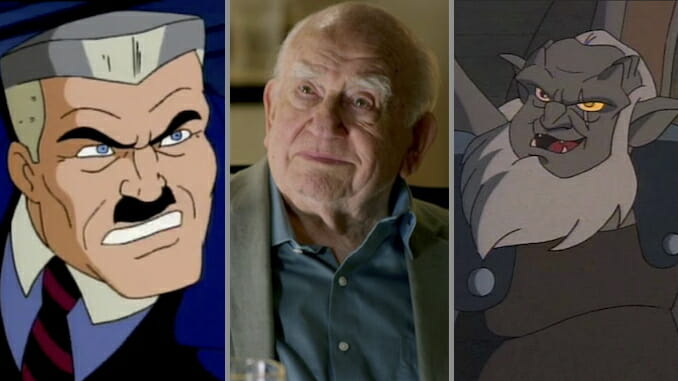For a Generation, Ed Asner’s Legacy Was the Crotchety King of Cartoon Voiceover
Remembering the prolific actor’s cartoon renaissance.

Ed Asner was one of those actors whose careers were so insanely prolific you could stop a person of any age and get completely different answers when you ask them what they’ve seen him in. He was an integral part of The Mary Tyler Moore Show, providing the chauvinistic foil to the heroine in his portrayal of brusque old newsman Lou Grant. He acted in old Hollywood Westerns, gave pathos to a slave ship captain in Roots and even popped up as a crotchety old suit in Curb Your Enthusiasm, all of them memorable turns.
Younger generations, though, might remember him best for one of his mightiest assets: That impossibly powerful voice. Asner was a short, stocky guy, one who in his earlier career looked older than his age. One of the reasons he seemed so imposing though was that crusty, rough, nuanced voice, and the obvious glee with which he deployed it to portray a lifetime of characters filled with tenderness underneath their prickly exterior. Asner clearly reveled in the power he had to create characters whose angry facade hid vulnerability, and relished the chances he got to play a bad guy so that he could wink knowingly at the audience. Nowhere was that gift better put to use than in Asner’s mile-long list of credits in cartoon voiceovers.
Voices like Asner’s were what got me interested in voiceover actors and the intricate craft involved in creating characters through voice. Simply put, Asner’s voice was so recognizable that when I heard him in more than one place, I wanted to know the name of the guy behind that crusty growl.
You can tell from Asner’s voice that his was a life thoroughly lived. He served his country in the Army Signal Corps and worked in a factory for General Motors, and you can somehow hear the depth of that kind of experience in his voice. You get the unmistakable impression, when he portrayed bit players in The Simpsons or chewed scenery as J. Jonah Jameson in the ’90s Spider-Man show, that he was making deliberate choices as an actor.
His Jameson was a loudmouthed, sanctimonious lout, in the best tradition of a really good Asner villain—that is to say, the kind Asner played as an obvious strawman. And yet, he was also capable of giving the guy some pathos. The villains in Batman: The Animated Series are some of the most nuanced in cartoon history underneath their scarred faces and domino masks, but Asner ranked among the most straight-forwardly evil when he portrayed ruthless capitalist Roland Daggett.
Daggett shows up in several really good episodes, usually when some other more colorful villain like Catwoman or Clayface is involved. What’s telling is that Daggett’s only superpowers are dirty money and Asner’s inimitable voice, but it is nonetheless perfectly clear to the after-school crowd that Daggett is way more of a threat to Gotham and to Batman than the caped crusader’s costumed foes.